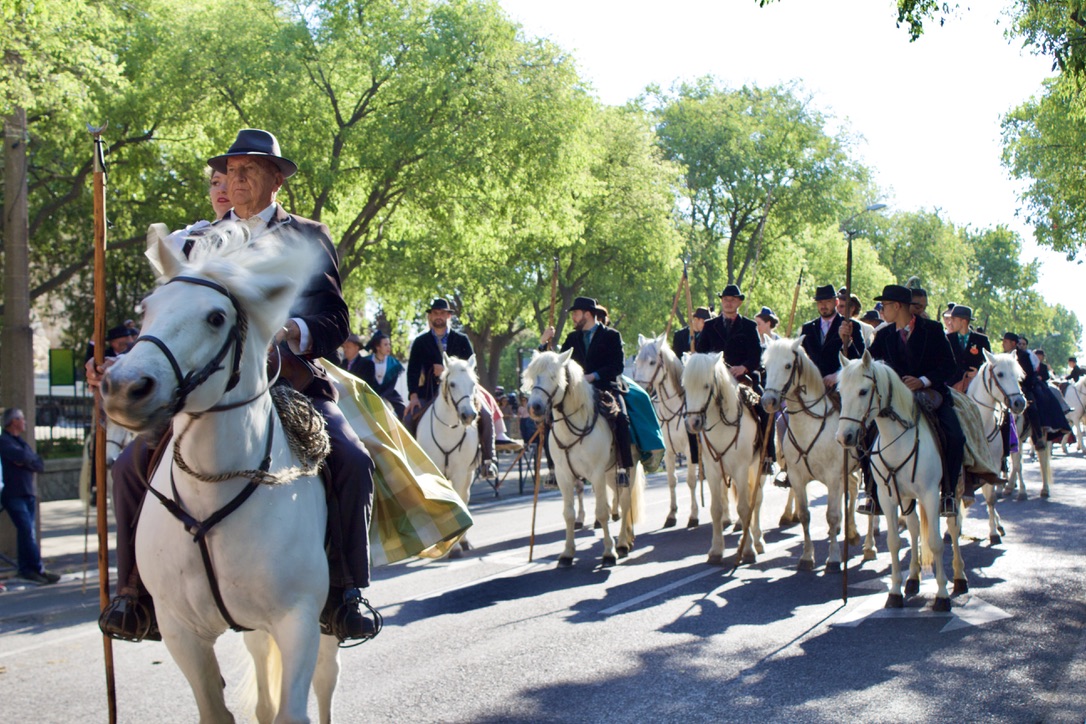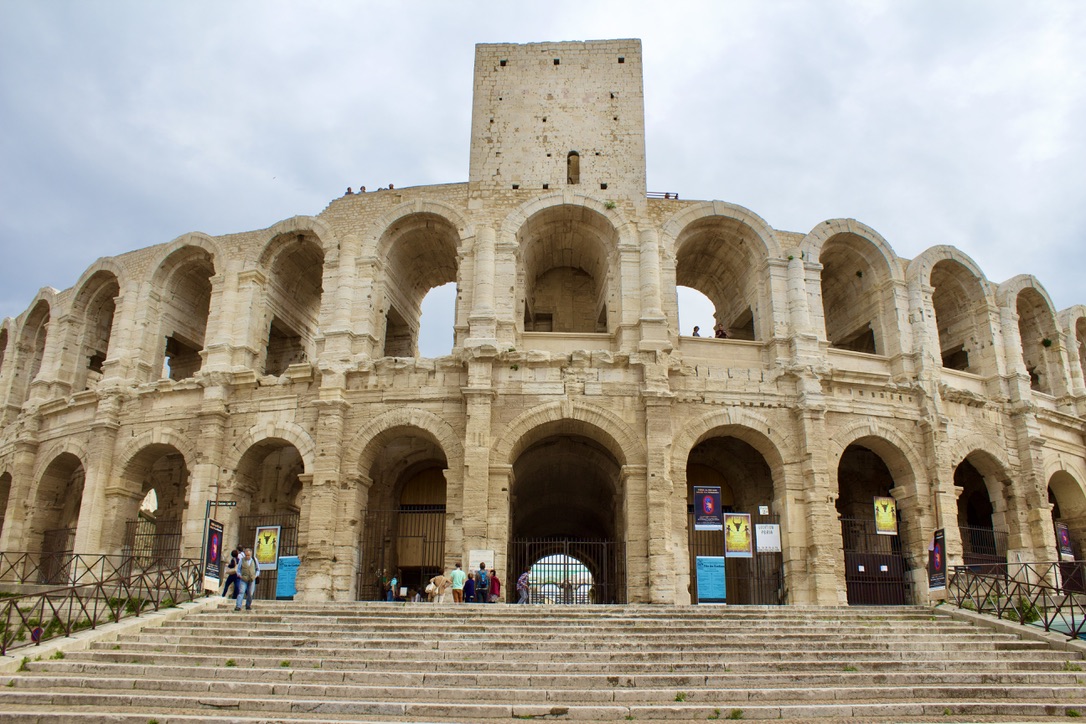ARLES - WORLD HERITAGE SITE BY UNESCO
Arles is situated in the Rhône river delta, at the foot of the Alpilles dans le département des Bouches-du-Rhône en région Provence-Alpes-Côte d'Azur. The town has a rich historical and architectural heritage dating from the time of the Roman Empire, the Medieval, and Renaissance periods.
The feast of Arles is organized on May 1st each year by the Brotherhood of the Guardians.

CITY OF ART AND HISTORY
Since 1986, the city has been also classified as a “City of Arts and History".
Among the historic sites referenced as “Historic Monuments” and designated as an “World Heritage Site” by Unesco are the Amphitheatre (Arena), Roman theater, Cryptoportiques, Baths of Constantine, Alyscamps, Ramparts, the remains of the Circus of the Roman period, and the cloister and portal of St.Trophime built between the 12th and 14th centuries.
The sixteenth, seventeenth, eighteenth centuries represented years of prosperity for Arles as evidenced by its beautiful buildings dating from the period.
ROMAN TOWN
The foundation of the Roman colony in Arles dates from the first century BC. Its founding is linked to the creation of the trade route between Rome and Spain. Among the remains from this period are amphitheater, ancient theater, forum, baths and circus.
ARENES (AMPHITHEATER)

Amphitheater dated 1st century BC. It could hold up to 21,000 spectators.
Open for visits:
- 10:00am-5:00pm November thru February;
- 9:00am-6:00pm March thru October;
- 9:00am-7:00pm May thru September;
Closed 1st May and 1st November.
Address: 1 Rond-point des Arènes, 13200 Arles

THEATER ANTIQUE
Theater Antique dated 1st century BC. It could hold up to 10,000 spectators.
Address: Rue du Cloître, 13200, Arles
FORUM AND THE CRYPTOPORTIQUE
The Forum, founded in 46 BC, featured a grand colonnade surrounding a public square. In the Roman tradition, the Forum consolidated the administrative, judicial, economic and religious administration of the Roman city. The two columns, and a piece of the facade with pediment, are the only existing ruins of the Forum of Arles. They are dated from the 2nd to the 4th centuries AD.
The Cryptoportiques present what remains of the underground galleries of the Forum, which in Roman times housed shops and places of amusement. Such galleries date from the first century BC. At that time, the galleries were partly open to the sky and the actual ground level was at a lower elevation. One can explore the underground remains today.
For visiting, the Cryptoportiques are open:
- 10:00am-12:00pm and 2:00pm-5:00pm November thru February;
- 9:00am-12:00pm and 2:00pm-6:00pm March thru October;
- 9:00am - 12:00pm and 2:00pm - 7:00pm May thru September;
Closed 1st May and 1st November.
Address: Place de la République, 13200, Arles
BATHS OF CONSTANTINE
The Baths of Constantine dated after the fourth century AD.
Open for visits:
- 10:00am-12:00pm and 2:00pm-5:00pm November thru February;
- 9:00am-12:00pm and 2:00pm-6:00pm March thru October;
- 9:00am-12:00pm and 2:00pm-7:00pm May thru September.
Address: Rue du Grand Prieuré, 13200 Arles
ALYSCAMPS
Roman and medieval necropolis and Saint Honorat Church.
Open for visits:
- 10:00am-12:00pm and 2:00pm-5:00pm November thru February;
- 9:00am-12:00pm and 2:00pm-6:00pm March thru October;
- 9:00am-12:00pm and 2:00pm-7:00pm May thru September;
Closed 1st May and 1st November.
Address: Avenue des Alyscamps, 13200 Arles
CIRCUS
The Departmental Museum of Ancient Arles is built on the remains of the Roman circus.
MUSEUM DÉPARTEMENTAL ARLES ANTIQUE
The archaeological collections of the County Museum of Ancient Arles present the architecture and operation of the Roman baths, as well as models of all ancient monuments, Roman and Gallic-Roman.
The museum is open for visits every day except Tuesday from 10:00am to 6:00pm.
Address: Avenue 1ere division de la France libre, presqu'île du cirque romain, 13635 Arles cedex
ARLES IN THE MIDDLE AGES
ST. TROPHIME CATHEDRAL
Classified as an national historic monument in 1840, the St. Trophime Cathedral was designated an "World Heritage Site" by UNESCO in 1981.
The cathedral is one of the most important among the Provençal Romanesque style edifices. It was built during the 12th through 15th centuries. Its Provençal Romanesque portal was built during the 12th century. Its church also features relics found along the road to Compostela. A Gothic choir loft eventually replaced the Romanesque apses of the 15th century.
THE CLOISTER AT ST. TROPHIME
Two Romanesque galleries and two Gothic galleries are dated from the 12th through the 14th centuries and form the cloister. Remarkably preserved statues adorn the aisles.
The site includes a beautiful stature of St Trophime and an allegory of the life of Christ.
Besides these religious evocations, there are also references to local folklore, such as a beautiful figure of the Tarasque, the mythological monster that haunted the voyagers of the Rhone and which was defeated by Saint Martha.
Open for visits:
- 10:00am to 5:00pm November thru February;
- 9:00am to 6:00pm March thru October;
- 9:00am to 7:00pm May thru September;
Closed 1st May and 1st November.
Address: Place de la république, 13200 Arles
THE ABBEY OF MONTMAJOUR
Located on the outskirts of Arles, on the road to Fontvieille, the Abbey was founded in 949 by the Benedictine community. Over more than eight centuries of monastic life, the monastery complex was enlarged and enriched by new buildings. In 1840, the Abbey was classified as a national historical monument following its restoration by Henri Révoil. In 1945, the abbey was formally designated state property.
For visits, the Abbey is open:
- 9:30am to 6:00pm April thru June;
- 10:00am to 6:30pm July thru September;
- 10:00pm to 5:00pm October thru March.
Address: Route de Fontvieille, 13200 Arles
ARLES : THE RENAISSANCE AND CLASSICAL PERIODS
From the late 15th to the mid-16th centuries, Arles thrived in economic, political, and social terms. The aristocracy lived in the town center and had built many sumptuous residences. In 1558, a belfry was erected in the heart of the city, currently located on the site of what is now known as Republic Square. Many mansions adorned with rich decorations were also built downtown, in Vieux-Bourg (Old Village), in Bourg-Neuf (New Village), and in the le Marché-Neuf (New Market). The construction that took place during the period of the 17th and 18th centuries gives Arles its current look: the design of both City Hall and its Republic Square reflect the change in style that came into fashion during the so-called ‘Royale’ period.
ARLES : CITY OF ART AND HISTORY
In 1987 Arles was designated as a "City of Art and History". This title draws attention to the fact that this city has placed a premium on its archaeological and architectural heritage and possesses a special sensitivity for the architecture of all former epochs.
RÉATTU MUSEUM: MUSEUM OF FINE ARTS IN ARLES
Located in the former palace of the Order of Malta, and the former house of Jacques Réattu, the Museum of Fine Arts of Arles is a historical monument. The museum's collection includes paintings by Jacques Réattu (1760-1833), and other painters of the 17th century, as well as the works of many contemporary artists. The museum was created by Elizabeth Grange, the only daughter of Réattu, who later donated the building and its collections to the City.
Woven hangings - unique collection of 16th and 17th century tapestries.
The hangings of Réattu Museum represent an exceptional collection of tapestries woven between the late 16th and 17th centuries including some that depict the ‘Seven Wonders of the World’: The Temple of Diana at Ephesus, the Mausoleum of Halicarnassus, the Hanging Gardens of Babylon (fragment only), the colossus of Rhodes, and the Coliseum. The tapestries and furniture on display once belonged to the Order of Malta, and previously to the Queen of Sweden, Christine (1632-1654). The woven tapestries of the ‘Seven Wonders of the World’ are kept in reserve and placed on public display on rotating basis.
For visiting, Museum Réattu open every day:
- 10:00am-5:00pm November thru February;
- 10:00am-6:00pm March thru October;
- 10:00am-7:00pm May thru September;
Closed 1st May and 1st November.
Address: Route de Fontvieille, 13200 Arles
MUSEON ARLATEN: PROVENCE OF 19th CENTURY
Founded in 1896 by Frédéric Mistral, in Hotel Laval-Castellane, which itself dates from the 15th century, the Museon Arlaten is the county’s Ethnographic Museum. It contains a collection of costumes, furniture, tools, objects of worship and superstition of life Provencal 19th century. The ethnographic museum is currently under renovation and will reopen in 2019.
ARLES: VAN GOGH, PHOTOGRAPHY AND MUSIC FESTIVAL
Vincent Van Gogh lived in Arles between February 1888 and May 1889. Approximately 300 drawings and paintings inspired by his stay in the Arles are on permanent display at the Museon Arlaten. Many places where the artist once placed his easel are marked by signs.
Arles is also a city of culture and tradition featuring two major events each year: In the summer, there is the “Meet Photography” event with photographic exhibitions and during the month of July a world renowned music festival.
FINE DINING IN ARLES: RESTAURANT LOU MARQUES
The restaurant "Lou Marquès" specializes in Provencal gourmet and traditional French cuisine.
The gourmet restaurant Lou Marques Arles offers a cuisine with sweet scents of Provence.
Head Chefs Pascal Renaud and Joseph Kriz will suggest to you fragrant and well-balanced dishes.
Following your meal, the dessert will be prepared by Chef Anne Beyl.
WINE TASTING: CHÂTEAUNEUF-DU-PAPE
The Chateauneuf-du-Pape appellation is situated about 52 km from Arles.
The history and development of the this appellation is related primarily to the installation of the Roman Catholic Popes in Avignon during the 14thcentury.
The culture of winemaking in the region probably dates back to Roman times, though the first written evidence of its existence dates only from 1157 AD.
In any event, it was through the patronage of the popes that wine of this appellation became well known. The vineyard now has 3,200 hectares spread throughout the towns of Châteauneuf-du-Pape, Bédarrides, Courthézon, Orange and Sorgue.
VINADÉA: WINE HOUSE CHÂTEAUNEUF-DU-PAPE APPELLATION
The appellation Châteauneuf-du-Pape consists of five (5) villages: Châteauneuf-du-Pape, Courthézon, Bédarrides, Sorgue, Orange.
Vinadéa, house wines of Châteauneuf-du-Pape, offers regular tastings of appellation wines. More than 200 different items are available for sale. Most bottles are sold at the same price as the property available individually or per case, with the possibility to be delivered anywhere throughout France.
The wine house is open every day:
- 10:00am-12:30pm and 2:00pm-7:00pm during summer;
- 10:00am-12:30pm and 2:00pm-6:30pm mid-season;
- 10:00am-12:00pm and 2:00pm-6:00pm during winter;
Closed in February, on December 25th, and January 1st.
Address: Wine house of Châteauneuf-du-Pape "Vinadéa",
8, rue Marechal Foch, BP 68 84232 Châteauneuf-du-Pape Cedex



